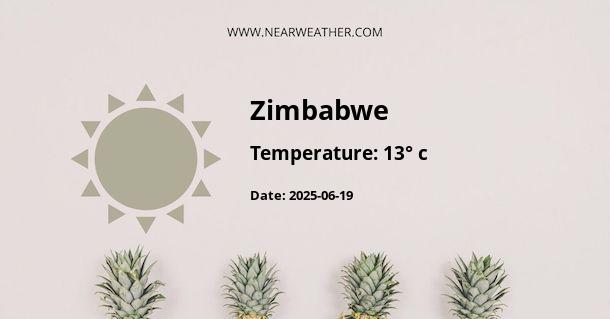Climate and Weather in Zimbabwe, ZW
Zimbabwe, located in southern Africa, experiences a diverse range of climates and weather conditions throughout the year. The country's climate is influenced by its topography, with varying altitudes and landscapes leading to distinct regional variations in temperature, rainfall, and seasons. Understanding the weather patterns in Zimbabwe is essential for travelers and residents alike to plan their activities and make the most of their time in this beautiful country.
Temperature
The temperature in Zimbabwe varies depending on the season and location. Overall, Zimbabwe has a mild and temperate climate, with the average annual temperature ranging from 20°C (68°F) to 28°C (82°F). However, temperatures can be higher in certain regions during the summer months.
In the summer season, which spans from November to March, temperatures can soar to highs of 30°C (86°F) or even higher in some areas. This period is characterized by hot and dry weather, with occasional thunderstorms and heavy rainfall. The eastern parts of Zimbabwe, such as the Nyanga Highlands, tend to be cooler due to their higher elevations.
During the winter months of May to August, temperatures across the country drop, especially during the night. Daytime temperatures range from 15°C (59°F) to 25°C (77°F), while nighttime temperatures can drop to around 5°C (41°F) or lower in some areas. The eastern highlands experience cooler temperatures compared to the rest of the country. It is advisable to pack warm clothing during this season, particularly for those planning to visit game reserves or go on early morning safaris.
Rainfall
Zimbabwe has a distinct wet and dry season, with the majority of the country experiencing a summer rainfall pattern. The wet season typically occurs from November to March, coinciding with the summer months. During this period, the country receives the bulk of its annual rainfall, particularly in the eastern and northern regions.
The western parts of Zimbabwe, including the popular tourist destination of Victoria Falls, experience lower rainfall amounts compared to the eastern regions. The average annual rainfall in Victoria Falls is around 600mm (24 inches). This drier climate makes it an ideal destination for travelers who prefer sunny and warm weather throughout the year.
The dry season, which runs from April to October, is characterized by sunny and dry weather with minimal rainfall. This period is particularly popular for wildlife viewing as animals tend to gather around water sources. However, it is worth noting that even during the dry season, occasional afternoon thunderstorms can occur in some parts of the country.
Seasons
Zimbabwe has four distinct seasons: spring, summer, autumn, and winter. These seasons align with the Southern Hemisphere, with opposite timings compared to countries in the Northern Hemisphere.
- Spring (September to November): Spring in Zimbabwe is a transition period between the dry winter and the wet summer. Temperatures start to rise, and the landscape begins to transform with the arrival of new foliage and blooming flowers.
- Summer (December to February): Summer in Zimbabwe is characterized by hot and humid weather. This is the wettest season, with heavy rainfall and occasional thunderstorms. It is a great time to witness the lush greenery and vibrant wildlife in the national parks.
- Autumn (March to May): Autumn is a beautiful season in Zimbabwe, with milder temperatures and decreasing rainfall. The landscape starts to change colors as leaves fall, creating picturesque scenes across the country.
- Winter (June to August): Winter in Zimbabwe is the dry season, with cooler temperatures during the day and chilly nights. This is an excellent time for game viewing, as the lack of foliage makes it easier to spot animals congregating around waterholes.
Best Time to Visit
The best time to visit Zimbabwe largely depends on the traveler's preferences and the activities they plan to engage in. The dry winter season, from May to August, is an ideal time for wildlife enthusiasts as animals gather around water sources, making it easier to spot them on game drives and safaris.
For those interested in exploring the country's natural wonders, such as Victoria Falls, the period from April to October provides the best opportunity. The water levels are lower, allowing for a clearer view of the falls, and the weather is generally pleasant with minimal rainfall.
Travelers who enjoy lush green landscapes and want to experience the vibrant flora and fauna should consider visiting during the summer season, from November to March. Although rainfall is more frequent during this period, it also brings out the natural beauty of the national parks and reserves.
It is essential to check weather forecasts and plan accordingly when visiting Zimbabwe, as weather patterns can vary from year to year.
In conclusion, Zimbabwe offers a diverse climate and weather experience throughout the year. From hot and wet summers to mild and dry winters, the country has something to offer for every type of traveler. Whether you are interested in wildlife viewing, exploring natural wonders, or simply enjoying the beautiful landscapes, Zimbabwe's climate provides a unique backdrop for an unforgettable experience.
A - Zimbabwe's Latitude is -20.266670 & Longitude is 30.916670.
A - Weather in Zimbabwe is 29° today.
A - Climate Conditions in Zimbabwe shows overcast clouds today.
A - Humidity in Zimbabwe is 54% today.
A - Wind speed in Zimbabwe is 14.9 km/h, flowing at 123° wind direction. today.
